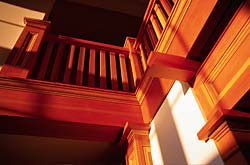Budget Leftovers: Make the Most of Your Home Improvement Dollars
See if We Have Top-Rated
Home Improvement Professionals in Your Area

According to the National Turkey Federation, Americans consume approximately 690 million pounds of turkey during Thanksgiving, but as much as half of this turkey may actually be eaten as leftovers during the Thanksgiving Day weekend. True turkey lovers can become just as excited by the soups, salads, and sandwiches as the initial turkey and stuffing. So it can be with your home improvement budget.
Remodeling and Addition Leftovers
Any number of things can go awry with a major home remodel. Once you've torn down the walls, even well-maintained homes can find water damage and rot. If you're replacing your floor, deterioration of sub-flooring can lead to an extensive and unplanned overhaul of this area before your new tile, hardwood, or laminate flooring can be installed. Kitchen designers are responsible for the measurements and materials of the remodeling plan, not the work of the installers. General contractors are responsible for the work of their subcontractors, but they may not be responsible for pre-existing damage in your home. Thus, it's never a bad idea to pad your budget.
Here is the advice of a Boston homeowner who completed a $20,000 home renovation, "Have about 10 percent flexibility in your budget. You will likely find things you want to add/change while the work is in progress."
Preserving Leftovers: Invest in Your Home or in Savings?
Preserving leftovers from your 19-pound turkey can be as easy as aluminum foil and a refrigerator. Preserving leftover home improvement funds are a lot trickier. As a long-term investment, the stock market looks pretty appealing, but what if you're close to retirement or you want to use these funds for next year's home improvement projects? Government bonds are virtually risk-free, but returns on these investments may have trouble keeping up with inflation. The truth is investing in your home, rather than any money markets, might just be the safest investment. Whether you replace a single window, upgrade your attic insulation, or install more energy-efficient/water-conserving appliances, investing in your home will reduce your utility bills and increase the value of your home.
Take, for example, a single high-efficiency toilet (HET). According to the Environmental Protection Agency, the average person uses 100 gallons of water each day. A typical HET can cost $125 to $250. If you're replacing an older toilet that still uses 3.5-5 gallons per flush, this new toilet can save you up to $90 per year in water bills and up to $2,000 over the lifetime of the toilet. Now, that's using your leftover funds wisely.
Small, Inexpensive Home Improvements
Here is a list of home improvement projects, which cost $500 or less, according to HomeAdvisor, an online resource linking homeowners and home improvement contractors:
Window Hardware, Latches, or Tracks: $100-$300
Most homeowners don't realize the number of inexpensive projects that can still make a measurable impact on your home. Maybe it's time to repaint one or more of your rooms. Maybe you need to refresh your window dressing schemes. Maybe a water or air purification system would make for a healthier household. Take a look around and you're sure to find some worthwhile ways to spend your budgetary leftovers.
Ceiling Fans: $200-$400
New Electrical Wiring, Outlet, or Switch: $250-$450
Cleaning Services (maid, windows, carpets, gutters): $100-$500
Cabinet Knobs or Pulls: $50-$500
Plumbing or Lighting Fixtures: $50-$500
More Tips & Advice For Your Home
- Related Articles
- Recent Articles

